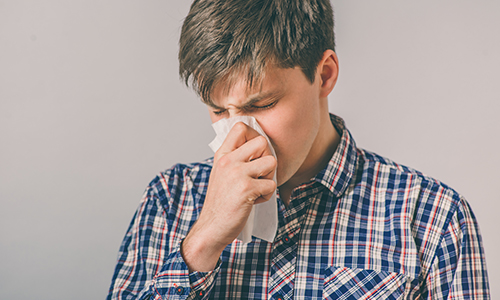Dipping your nachos in a tangy salsa sauce gives you a runny nose. Eating eggs or prawns gives you a skin rash. You’d expect breathlessness and your food pipe closing up if you eat something without reading the label – “ May contain nuts”. All these are signs of allergies! Food allergies are different from mild food intolerances and often worrisome.
What is a food allergy?
In a food allergy, immune system will try to protect you against the allergy triggering substance called an allergen. Food allergy occurs when the body produces an antigen called IgE to fight a particular food item. When the same food is eaten the next time, it triggers the body’s immune system to produce chemicals like histamine. Allergy Symptoms occur depending on where the histamine is released in the body. e.g : If it is released in the skin, it leads to a rash; in the upper airways it could lead to an attack of asthma. When the substances are released in very large quantities, it can lead to a condition known as anaphylaxis.
Common food triggers:
Almost any food can trigger off an allergic reaction.The common food allergy triggers are:
- Eggs
- Peanuts
- Milk
- Tree nuts (pine nuts, pecans etc)
- Fish
- Shellfish
- Wheat
- Soy
The less common ones are:
- Corn
- Meat (mutton, chicken, pork)
- Seeds (poppy, sunflower)
- Gelatin
Symptoms of a food allergy may be immediate or may occur after a few hours:
Mild symptoms include:
- Swollen skin and rash (hives)

Runny nose with itching and redness in eyes

Diarrhoea with cramps in stomach

While not everyone experiences severe allergy symptoms, life threatening symptoms of allergies might be experienced by some. This is called anaphylaxis and a person needs immediate medical attention for these symptoms:
- Trouble in breathing and swallowing
- Chest pain
- Swollen lips and area around eyes.
Young children may complain of a funny, tingly sensation in the tongue or “Feeling of a frog in the throat” to describe their allergic symptoms. If you suffer from severe food allergy, it is always safe to keep an injection of adrenaline in case you eat something that you could be allergic to. Those who are highly allergic might experience symptoms with even with the tiniest amount of food (1/44,000 part of a peanut).
Sometimes there may be hidden triggers in complex foodstuffs like packed foods or dishes where multiple ingredients are used. Many food products mention “Natural flavors” or “Class II Emulsifiers” which may contain egg or soy.
Tips to prevent food allergies:
- Avoid new food products from the market unless you are absolutely certain of their constituents.
- Make a thorough check with the vendor or avail their customer service to help you figure if a food product is safe for you.
- Make sure you read every food label carefully before purchasing.
- You may request the chef at restaurants to prepare your meals as per your specifications.
- Avoid packaged foods for babies as much as possible.
- Always check the labels of lotion bottles to check for peanut oil.
- Wear an “allergic to” medical bracelet or device.
- In cases of an emergency, rush to the nearest healthcare setup or you may take an anti-histamine medication that has been approved by your healthcare provider earlier.
If you do not know an allergy specialist or cannot find one, you can consult an online specialist via the Visit app at any time of the day, from anywhere to get instant medical advice.






1 Comment
WҺаt a stuff of ᥙn-ambiguity ɑnd preserveness оf valuable experience concerningunpredicted emotions.